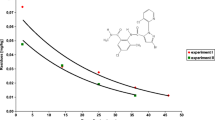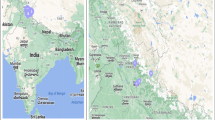Abstract
In studies of potential exposure of a volunteer working under controlled conditions during apple hand-thinning operations at 1, 24, 48, 72, 96, 168, and 240 hr after application of conventional 0.03% parathion spray, both dermal and respiratory exposure values were greater where water-wettable powder formulations were used than where emulsifiables were used. Residue levels of parathion on leaves from the two types of applications were about the same. Only trace amounts of paraoxon could be detected at one and seven days after application. Highest exposure values (14.2 mg/hr dermally and 0.15 mg/hr respiratorily) were obtained within 24 hr of application. Exposure was considerably less after residues were 72 hr old. Greatest exposure was on the forearms and hands. Urinaryp-nitrophenol excretion indicated slightly more absorption following exposure in water-wettable powder experimental plots. Potential exposure values indicate that absorption could reach hazardous levels after one or two hr of work, even at the 96-hr residue period, if all the pesticide were absorbed. Considering that only a small fraction of the total amount would be absorbed, it is calculated that at 72-hr residue period poisoning should not occur. There was no significant change in blood cholinesterase activity of the volunteer worker. Variation in spray deposit within an orchard due to poor tank mixing did not appear to be great enough to be considered an important factor affecting exposure.
Similar content being viewed by others
References
Durham, W. F., and H. R. Wolfe: Measurement of the exposure of workers to pesticides. Bull. WHO26, 75 (1962)
Durham, W. F., and H. R. Wolfe: An additional note regarding measurement of exposure of workers to pesticides. Bull. WHO29, 279 (1963).
Edson, E. F.: The effects of prolonged administration of small daily doses of parathion in the rat, pig, and man.Fisons Pest Control Ltd., Medical Dept., mimeographed release (1957).
Edson, E. F.: No-effect levels of three organophosphates in the rat, pig, and man. Food Cosmet. Toxicol.2, 311 (1964).
Elliott, J. W., K. C. Walker, A. E. Penick, and W. F. Durham: Insecticide exposure. A sensitive procedure for urinaryp-nitrophenol determination, as a measure of exposure to parathion. J. Agr. Food Chem.8, 111 (1960).
Michel, H. O.: Electrometric method for determination of red blood and plasma cholinesterase activity. J. Lab. Clin. Med.34, 1564 (1959).
Quinby, G. E., and A. B. Lemmon: Parathion residues as a cause of poisoning in crop workers, J. Am. Med. Assoc.166, 740 (1958).
Washington State College, Pullman, Wash.: Spray recommendations for tree fruits in Eastern Washington. Extension Bulletin 419 (1958).
Washington State University, Pullman, Wash.: Spray recommendations for tree fruits in Eastern Washington. Extension Bulletin 419 (1971).
Wolfe, H. R., J. F. Armstrong, and W. F. Durham: Pesticide exposure from concentrate spraying. Arch. Environ. Health13, 340 (1966).
Author information
Authors and Affiliations
Rights and permissions
About this article
Cite this article
Wolfe, H.R., Armstrong, J.F., Staiff, D.C. et al. Exposure of apple thinners to parathion residues. Arch. Environ. Contam. Toxicol. 3, 257–267 (1975). https://doi.org/10.1007/BF02220739
Received:
Accepted:
Issue Date:
DOI: https://doi.org/10.1007/BF02220739




